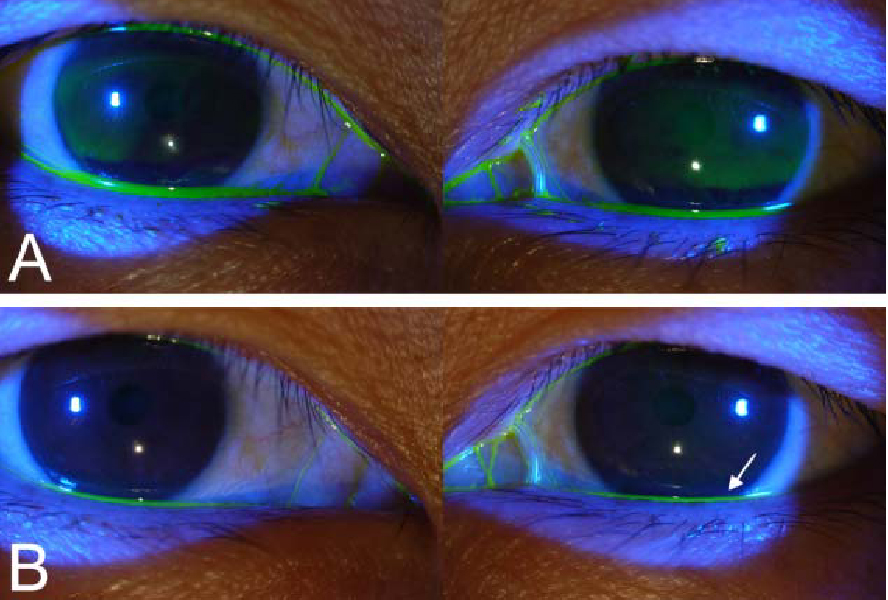Korean J Ophthalmol.
2007 Jun;21(2):70-73. 10.3341/kjo.2007.21.2.70.
Lacrimal Silicone Intubation for Anatomically Successful but Functionally Failed External Dacryocystorhinostomy
- Affiliations
-
- 1Department of Ophthalmology, Seoul National University College of Medicine, Seoul, Korea. khwarg@snu.ac.kr
- 2Department of Ophthalmology, Seoul National University Bundang Hospital, Seongnam, Korea.
- 3S eye Center, Ansan, Korea.
- 4Department of Ophthalmology, DongGuk University International Hospital, Goyang, Korea.
- 5Department of Ophthalmology, Seoul Municipal Boramae Hospital, Seoul, Korea.
- 6Department of Ophthalmology, University of Ulsan College of Medicine, Asan Medical Center, Seoul, Korea.
- KMID: 1101906
- DOI: http://doi.org/10.3341/kjo.2007.21.2.70
Abstract
- PURPOSE: To investigate the efficacy of lacrimal silicone intubation for the management of epiphora in patients who have previously undergone anatomically successful dacryocystorhinostomy (DCR). METHODS: The authors recruited 13 patients (4 male, 9 female) who had persistent epiphora after an anatomically successful primary external DCR and conducted lacrimal silicone intubation through the dacryocystorhinostomy site. RESULTS: Mean patient age was 54.2 years (range 42-80) and mean follow-up was 13.8 months (range 6-30). Epiphora was resolved in all 13 patients following silicone intubation. Spontaneous tube extrusion occurred in three patients, but a new one was easily reintubated. CONCLUSIONS: Lacrimal silicone intubation is a simple safe and effective procedure for patients with epiphora even after anatomically successful DCR.
MeSH Terms
Figure
Cited by 1 articles
-
Cause and Management of Patients With Failed Endonasal Dacryocystorhinostomy
Ji Sun Baek, Seong Hun Jeong, Jung Hye Lee, Hye Sun Choi, Sung Joo Kim, Jae Woo Jang
Clin Exp Otorhinolaryngol. 2017;10(1):85-90. doi: 10.21053/ceo.2016.00192.
Reference
-
1. Tarbet KJ, Custer PL. External Dacryocystorhinostomy: surgical success, patient satisfaction and economic cost. Ophthalmology. 1995. 102:1065–1070.2. Welham RA, Henderson PH. Results of Dacryocystorhinostomy: analysis of causes for failure. Trans Ophthalmol Soc UK. 1973. 93:601–609.3. Delaney YM, Khooshabeh R. Fluorescein transit test time and symptomatic outcomes after external dacryocystorhinostomy. Ophthal Plst Reconst Surg. 2002. 18:281–284.4. Amin M, Moseley IF, Rose GE. The value of intubation dacryocystography after Dacryocystorhinostomy. Br J Radiol. 2000. 73:604–607.5. Conway ST. Evaluation and management of 'functional' nasolacrimal blockage; results of a survey of the American Society of Ophthalmic Plastic and Reconstructive surgery. Ophthal Plast Reconstr Surg. 1994. 10:185–187.
- Full Text Links
- Actions
-
Cited
- CITED
-
- Close
- Share
- Similar articles
-
- Results with Silicone Stent in Lacrimal Drainage System
- Treatment of Congenital Nasolacrimal Duct Obstruction Using Silicone Intubation Set
- Silicone Tube Intubation with Lacrimal Endoscopy and Endonasal Dacryocystorhinostomy in Adult Nasolacrimal Duct Obstruction
- Silicone Intubation in Children with Nasolacrimal Duct Obstruction
- Silicone Intubation for Functional Nasolacrimal Duct Obstruction



